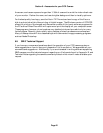
Section 5 - Advanced Imaging Techniques
Page 36
5. Repeat steps 3 and 4 as many times as desired for all the objects you wish to
image, each time choosing a set of corresponding new names for the IMAGE
and TRACK files.
6. You will now create a combined flat field image for each Track and Accumulate
image you captured. Invoke the Add by Track List command. The software
will bring up a file directory dialog showing all the track list files. Select the
TRACK file corresponding to the image you wish to correct. The software will
load the TRACK file and present you with another file directory dialog showing
all the images. Select the appropriate FLAT image. The software will align and
co-add the FLAT image using the same operations it performed on the Track
and Accumulate image. Finally save the combined flat field image using the
Save command. In the following discussions this combined flat field image will
be referred to as COMBINED-FLAT. Repeat this step for each of the TRACK
files using a corresponding name for the COMBINED-FLAT image.
7. You will now flat field correct the Track and Accumulate image with the
combined flat field image. Use the Open command to load the IMAGE file, then
use the Flat Field command. The software will present you with a file directory
dialog where you should select the corresponding COMBINED-FLAT image.
After the software has finished correcting the image you can view the results
and save the flat field corrected image with the Save command. This image will
be referred to as the CORRECTED-IMAGE file. Repeat this step for each of the
IMAGE files using the corresponding COMBINED-FLAT image.
At SBIG we have adopted the following naming convention for our various image and related
files. If it helps you organize your files please feel free to adopt it or any method you feel helps
sort out the process of naming files:
Image type Name
Uncorrected image (IMAGE) XXXXXXXX. (blank extension)
Flat field file (FLAT) FLATXXXX. (blank extension)
Track list file (TRACK) XXXXXXXX.TRK
Combined flat field (COMBINED-FLAT) FLATXXXX.C
Flat field corrected image (CORRECTED-IMAGE) XXXXXXXX.F
5.8. Tracking Functions
The CCDOPS software allows your ST-7E/8E/9E/10E/1001E to be used as an autoguider or
self-guided (except ST-1001E) imager. It does not function as a stand-alone autoguider like the
ST-4, but instead requires using a PC to perform the function. These cameras have
considerably better sensitivity than the ST-4.
CCD autoguiders alleviate you from having to stare down the eyepiece for hours at a
time while guiding astrophotographs. They are not the end-all, cure-all approach to telescope
mechanical problems, though. You still need a good polar alignment and a rigid mount
between the guide scope and the main scope or you need to use an off-axis guider, with all its
inherent difficulties. A good declination drive, free of backlash, is desirable although not


















